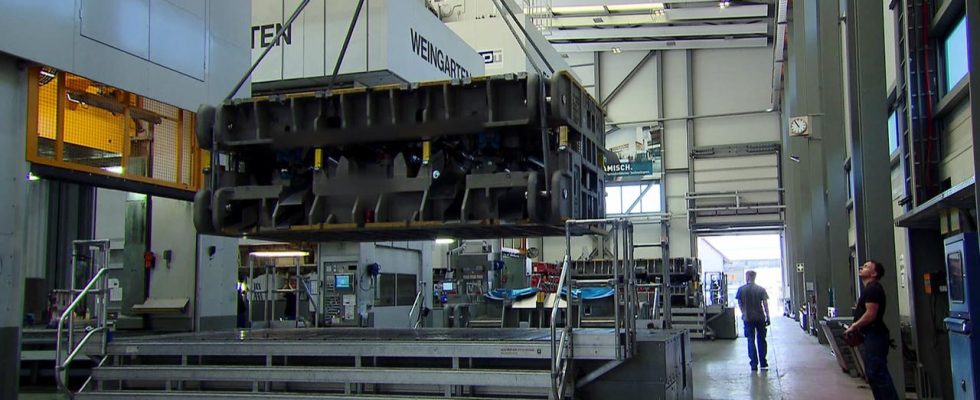Many medium-sized companies no longer want to rely on the automotive industry as their sole customer. You are looking for new business areas. The EBZ Group in Ravensburg, for example, relies on hydrogen.
Rarely can one see the awakening more clearly than in Plant 2 of the EBZ Group in Ravensburg. Because while down in the huge hall, gripper arms and transport systems for the automotive industry are manufactured, among other things, a new office area is enthroned under the old hall roof. This is called “TIC”, “Technology and Innovation Center”. It contains chic furniture, a few plants, a tea kitchen and people working on the future of the company in front of their monitors.
Because that can no longer lie in the automotive industry alone, of that we are convinced. “We continue to believe in the automotive industry, we are not on the run there. But we also want to build up a relevant business area in hydrogen electrolysis,” explains Alexander Schmeh, CEO of the operative business. Because the medium-sized company still generates 95 percent of its sales with projects for the automotive industry, for example with the pressing of car bodies. But that should change.
rethinking in transformation process
A few years ago, when the transformation process started, the battery assembly market was first approached. But even that is finite in terms of development opportunities, according to Schmeh: “Our customers now know how to develop and design electric cars, but they also feel that the market is not buying these vehicles in all products in terms of quantity and price.”
So the decision was made at EBZ to take another strategic step towards hydrogen, more precisely: towards the electrolyser. “Electrolysers can produce green hydrogen from renewable electricity by splitting water into oxygen and hydrogen,” explains Marc-Simon Löffler.
The prototype of an electrolyser from the EBZ Group
New business field hydrogen
Löffler opens a grate behind which an impressive machine is hidden. As high and long as a carport, with silver pipes, in the middle a huge “stack”, a layering of electrolysis cells.Here, in the center for solar energy and hydrogen research in Stuttgart, is this prototype of an electrolyser. What is special: 40 companies from Baden-Württemberg were involved in its construction. “We built the electrolyser to activate companies in Baden-Württemberg, to motivate them to get involved in product development and to build up production capacities at state level,” says Löffler.
In particular, they wanted to address medium-sized companies from the automotive supplier sector, since the transformation process is currently causing business areas to collapse in many places. The potential here is particularly large.
Rethinking before burner off
In fact, the end of combustion engines announced by the EU in 2035 has caused unrest in the automotive state of Baden-Württemberg. Big names are based here: Daimler and Porsche in Stuttgart, Audi in Neckarsulm. And accordingly, many companies around that have previously only been active as suppliers in the automotive industry.
“You always look at the automotive companies themselves, but the situation is even more explosive at the moment with the suppliers,” says Helena Wisbert, automotive expert from the Ostfalia University of Applied Sciences. “If they were previously in the business areas that are now being phased out, such as powertrains or combustion engines, they have to change their entire product portfolio.” Many have already done so, as can be seen from the patent applications in recent years. “We’re seeing a lot more registrations there in the field of e-mobility or fuel cells,” says Wisbert.
Energy import country Germany
And with the latter, hydrogen comes into play again, because it is needed to drive a fuel cell. Investing in this energy source is therefore definitely the right way, says Karsten Lemmer from the German Aerospace Center: “The current demand for hydrogen in Germany is around 55 terawatt hours per year and could increase to around 946 to 1364 terawatt hours per year by 2050 to cover the needs of all sectors.”
“All sectors” here means the large ones, such as ammonia production or the steel industry, as well as the much smaller area of mobility. But, as Lemmer points out: “We will not be able to cover demand from Germany. From today’s perspective, Germany will always remain an energy importing country.”
At the EBZ Group in Ravensburg, planning for the new hydrogen product field is already well advanced. A prototype of an electrolyser should be ready before the end of this year. In the coming year, the company wants to go into small series and then produce larger quantities from 2025. In the long term, the EBZ Group hopes that electrolyser production will account for 25 percent of sales. And thus offers the company a solid second mainstay – in addition to the automotive industry.

